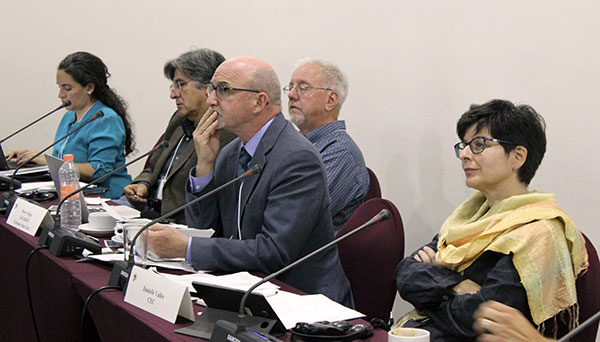Using volunteer observer networks to monitor precipitation and wildfires
Crowne Plaza Hotel de México – Salón Holiday 3, Dakota 95, Nápoles, Benito Juárez, Mexico City
Mexico
25 and 26 September, 2019
Semi-Private
Meeting to assess the feasibility of establishing and expanding the CoCoRaHs network and other citizen science observers networks to complement national and subnational observational capacities.

Agenda
DAY 1 (Wednesday)
The goal of the project, Using volunteer observer networks to monitor precipitation and wildfires, is to assess information needs and gaps relative to precipitation and wildfires and the feasibility of expanding citizen science and volunteer observation networks across North America, to complement national and sub-national capacities to prepare for and respond to extreme events. The specific objectives of the present meeting, which has been organized in support of this project, are:
- To discuss the expansion of the Community Collaborative Rain, Hail and Snow, (CoCoRaHS) network in North America; and
- To assess the feasibility of establishing or expanding other networks across the region.
Registration
Session 1: Welcome and Introductions; Objectives of the Meeting
- Orlando Cabrera, Head, Environmental Quality Unit, Commission for Environmental Cooperation (CEC)
- Jorge Zavala Hidalgo, General Coordinator, National Meteorological Service (Servicio Meteorológico Nacional)
Session 2: Monitoring and prediction of precipitation and wildfires in Mexico:
Capacities, gaps, and needs

Observation and Telematics Networks,
National Meteorological Service (Servicio Meteorológico Nacional, SMN)
Download Presentation

Atmospheric Sciences Center (Cientro de Ciencias de la Atmósfera),
Universidad Nacional Autónoma de México (UNAM), Red Universitaria de Observatorios Atmosféricos (RUOA)
Download Presentation

Associate Manager, National Fire Management Center (Centro Nacional de Manejo del Fuego),
National Forest Comission (Comisión Nacional Forestal, Conafor)
Download Presentation
Break
Session 3: CoCoRaHS and the added value of a North American network

CoCoRaHS overview: Structure, volunteer engagement, coordination, quality control, data/technical needs, and relationships with other networks
Download Presentation

Manager, Atlantic Climate Centre,
Environment and Climate Change Canada (ECCC) Experience and lessons learned: Canada
Download Presentation

CoCoRaHS Puerto Rico
Experience and lessons learned: Puerto Ricoo,
Download Presentation
Lunch
Session 4: Benefits of collaborating with the CoCoRaHS network


Tribal Capacity and Training Program,
Local Environmental Observers (LEO) Network
Download Presentation
Break
Session 5: Feasibility of expanding the CoCoRaHS network: Factors to consider

CoCoRaHS United States
CoCoRaHS as a Model: Considerations for a successful volunteer network
Download Presentation

DAY 2 (Thursday)
Registration
Session 1: Re-cap of Day 1 – Key messages and lessons learned
- Orlando Cabrera, CEC
Session 2: Availability and communication of air quality and smoke data and information to protect public health
- Introductory comments –Annette Guiseppi-Elie, Associate Director for Exposure Science, National Exposure Research Laboratory, U.S. Environmental Protection Agency (EPA)
Session 3: Availability and communication of air quality and smoke data and information to protect public health: Mexican and Canadian perspectives

Director, Air Quality Management for Metropolitan Zones,
Environment Commission of the Megalopolis (Comisión Ambiental de la Megalópolis, CAMe)
Download Presentation

General Coordinator, Pollution and Environmental Health Division
National Institute of Ecology and Climate Change (Instituto Nacional de Ecología y Cambio Climático, INECC)
Break
Session 3 (cont’d): Availability and communication of air quality and smoke data and information to protect public health: Mexican and Canadian perspectives

Senior Scientist, B.C. CDC
British Columbia Centers for Disease Control (CDC)
Download Presentation
Session 4: Existing tools for communicating air quality, smoke/fire, and public health information

Directora, SIMAT – Secretaria de Medio Ambiente (SEDEMA),
Ciudad de México AIRE application
Download Presentation

Senior Policy Analyst, Air Quality & Health Forecast Services, Environment and Climate Change Canada (ECCC)
Firework Wildfire Smoke Prediction System
Download Presentation
Lunch
Session 4 (cont’d): Existing tools for communicating air quality, smoke/fire, and public health information

Principal Investigator, Smoke Sense, U.S. EPA
Smoke Sense project: Overview and findings
Download Presentation
Session 5: Perspectives of volunteer observation networks in North America

Director, Data Sciences, and Ana Marichal, GECI, Mexico
Island Ecology and Conservation Group (Grupo de Ecología y Conservación de Islas, GECI)
Download Presentation

Tribal Capacity and Training Program, LEO Network
Local Environmental Observer (LEO) Network, United States
Download Presentation
Session 6: Expanding Smoke Sense and other tools or networks: Factors to consider


EPA
Smoke Sense project: Next steps
Session 7: Opportunities for mutual collaboration across North America; next steps
Group discussion
Session 8: Closing remarks and meeting adjournment
- Orlando Cabrera, CEC